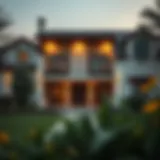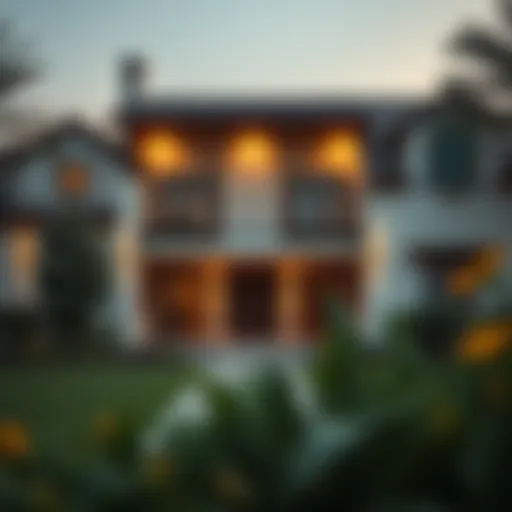Exploring the Rooftop Garden Lounge at Al Qana
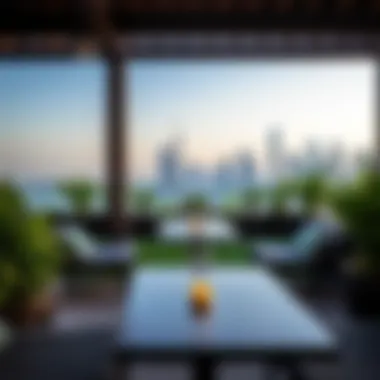
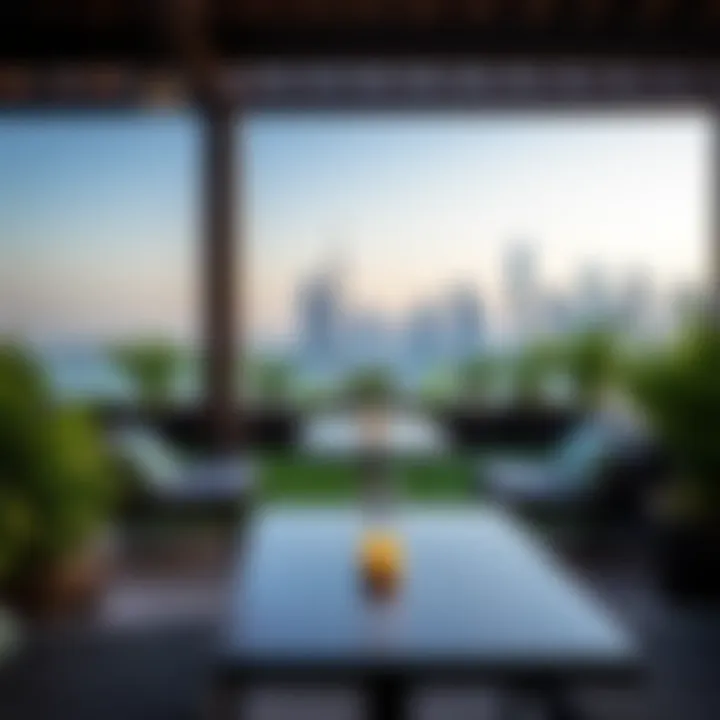
Intro
The rooftop garden lounge at Al Qana emerges as a vibrant oasis amidst the fast-paced backdrop of Dubai. This unique space masterfully blends the allure of nature with modern architectural finesse, serving as a sanctuary for residents and visitors alike. In a city bustling with life, this lounge not only provides a breath of fresh air but also reflects broader trends in urban design and sustainability. The seamless integration of greenery into urban environments is more than just a fad; it embodies a lifestyle choice that resonates with individuals seeking balance in an ever-demanding world.
By dissecting various elements of the rooftop garden lounge, we can uncover its significance in the context of modern living, consider its environmental implications, and analyze its cultural relevance. Each aspect sheds light on how such spaces can transform a city’s landscape and elevate the quality of urban life, making it an important subject for real estate investors and enthusiasts alike.
Prologue to Al Qana
Al Qana is not just a location; it is a vision come to life in the heart of Abu Dhabi, where tradition and modernity coexist in a harmonious blend. This vibrant development stands as a significant addition to the urban landscape, positioning itself as a focal point for cultural engagement and leisure activities. The importance of this article lies in its exploration of the rooftop garden lounge at Al Qana, which epitomizes the innovative spirit of urban design coupled with environmental consciousness.
The rooftop garden lounge is a sanctuary amidst the bustling city. It provides a unique integration of natural elements and urban living, promoting a sense of well-being and tranquillity that is often elusive in metropolitan areas. With an array of features designed to enhance the user experience, this lounge serves as a perfect example of how green spaces can revitalize cities and improve quality of life, making it vital to understand its components, benefits, and the overall vision behind Al Qana.
Location and Significance
Al Qana is strategically located near the waterfront, fostering a connection between nature and the urban environment. This prime location is not by chance; it was chosen to embrace and enhance the natural beauty surrounding the site, making it accessible for residents and visitors alike. The lounge offers sweeping views of the city skyline and the waters of the Arabian Gulf, creating a picturesque backdrop for relaxation and socialization.
Aside from its visual appeal, the incorporation of the rooftop garden lounge into Al Qana’s blueprint addresses several key issues:
- Urban Heat Mitigation: Rooftop gardens play a huge role in reducing urban heat. The plants, soil, and water in these spaces can help moderate temperatures in the surrounding environment.
- Biodiversity Support: By establishing a garden on the roof, Al Qana contributes to improving local ecosystems. It attracts various bird species and insects, promoting biodiversity amidst densifying urban areas.
- Community Engagement: This space encourages social interaction among diverse groups, fostering a sense of community and belonging among residents and visitors.
In summary, understanding the location and significance of Al Qana provides a foundation for appreciating its unique rooftop garden lounge. It reveals how urban developments can echo natural beauty and improve the quality of life.
Vision Behind Al Qana
The vision behind Al Qana draws inspiration from the rich cultural heritage of the United Arab Emirates while simultaneously looking toward the future. The developers aim to create a destination that serves not just as a leisure spot but as a cultural hub that nurtures art, wellness, and community engagement.
At the core of this vision is the belief in merging green spaces with urban living. The rooftop garden lounge exemplifies this philosophy, offering an escape from the hectic pace of city life.
> “Green spaces should not just be considered luxuries but essentials in city planning.”
This statement resonates deeply in Al Qana’s mission. The lounge is designed to cater to a diverse audience—from families seeking a weekend retreat to professionals looking for a quiet space away from their desks. Thus, the vision behind Al Qana emphasizes inclusivity and accessibility, ensuring that every visitor feels at home.
To achieve this, several principles are integrated into the design:
- Sustainability: Emphasizing eco-friendly practices, this development incorporates renewable energy solutions and efficient water usage.
- Cultural Recognition: Local arts and traditions are incorporated into the design, celebrating the UAE's rich history.
- Health and Well-being: The space is designed to promote physical and mental health, with features such as walking paths, flora, and spaces for relaxation, ensuring visitors leave feeling rejuvenated.
The Concept of Rooftop Gardens
The concept of rooftop gardens stands as a testament to the evolving relationship between urban landscapes and nature. As cities expand and the pressure on green spaces increases, the integration of greenery in buildings provides a vital counterbalance. Rooftop gardens offer a sanctuary, a slice of tranquility in the midst of bustling streets, making them an important element of modern architecture. This article delves into this concept, exploring its roots and the significant role it plays in enhancing urban living.
Historical Context
Historically, the idea of utilizing rooftops for cultivation or leisure is not novel. Ancient civilizations like the Persians, Egyptians, and even the Aztecs cultivated gardens atop their structures. For instance, the famous Hanging Gardens of Babylon, one of the Seven Wonders of the Ancient World, exemplified the ingenuity of merging architecture with horticulture. The concept persisted through the ages, albeit with variations, until the industrial revolution saw a shift in priorities. Advances in urbanization led to concrete jungles that overshadowed greenery, diminishing the presence of nature in city life.
While many urban centers became primarily sites of commerce and industry, the last few decades have seen a resurgence in interest toward rooftop gardens. As the impacts of urbanization on mental health and the environment have become increasingly acknowledged, cities began to reconsider this vital space. The 20th century saw many municipalities encouraging green roofs for their environmental benefits, such as improved air quality and energy efficiency. Thus, the historical journey of rooftop gardens reflects the persistent human desire to reconnect with nature, even amidst architectural constraints.
Modern Interpretation
In today's context, rooftop gardens embody more than just an aesthetic addition; they serve multiple functions that greatly enhance urban living. First and foremost, rooftop gardens contribute significantly to sustainability. By providing insulation for buildings, they help in reducing energy costs, and by absorbing rainwater, they mitigate runoff, which is critical in urban areas prone to flooding.
Moreover, these gardens foster biodiversity. They can attract various species of birds, butterflies, and other pollinators that are essential to maintaining ecological balance. This biodiversity aspect is crucial, as urban development often leads to the displacement of natural habitats, thus making rooftop gardens vital for preserving urban ecosystems.
In terms of social interaction, rooftop gardens in places like Al Qana create communal environments where people can unwind and connect. These gardens become spaces for relaxation, social gatherings, and even urban farming initiatives, promoting a sense of community that is often lacking in city life.
Furthermore, as homebuyers, investors, and developers seek spaces that promote wellness, the inclusion of rooftop gardens presents a smart investment opportunity. Properties featuring such gardens often see enhanced market appeal, attracting clientele that prioritize lifestyle quality over mere ownership.
The revitalization of rooftop gardens is a strong indicator of shifting urban design philosophies, from merely maximizing space to creating multifunctional areas that cater to both human and environmental needs. This evolution not only addresses the demands of modern living but also prepares cities for the future—where urban greenery is no longer an option but a necessity.
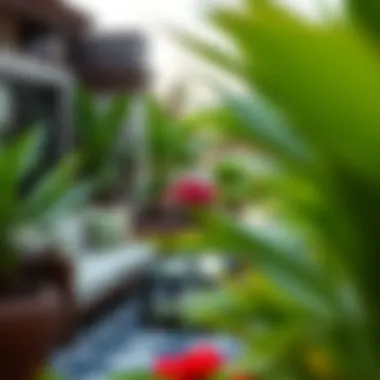
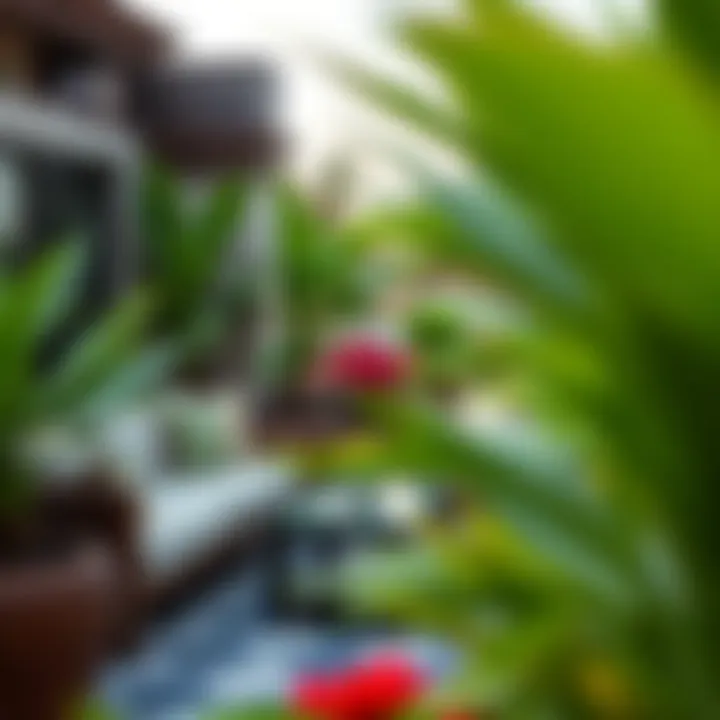
Design Elements of the Rooftop Lounge
The design elements of the rooftop lounge at Al Qana play a pivotal role in shaping not only the aesthetic of the space but also its functionality and environmental resilience. This section shines a light on how architecture, landscaping, and the choice of materials converge to create an inviting haven for relaxation and socialization amid the city's hustle and bustle. The rooftop lounge serves as a testament to what modern urban design can achieve, promoting a harmonious balance between nature and architecture, while also providing a wealth of benefits for the users.
Architectural Features
From the get-go, the architectural features of this lounge stand out. It is not just about stacking concrete and glass; it’s about creating a seamless flow between the indoors and outdoors. The overhangs that gracefully extend provide shade during those sweltering summer months, inviting patrons to enjoy the space even in peak sun hours. Large glass façades, designed to allow for maximum natural light, also frame stunning panoramic views of the surrounding cityscape.
The unique layout often uses a tiered design, which means visitors can experience various perspectives of both the skyline and the lush greenery. The incorporation of curves rather than sharp angles creates a more organic feel, which mimics the natural surroundings. This thoughtful design promotes an atmosphere that encourages relaxation and social interaction.
Landscaping Techniques
Landscaping techniques employed at Al Qana’s rooftop lounge further enhance the space’s appeal. It goes beyond mere decoration; it is about fostering an ecosystem. Experts focus on xeriscaping, which emphasizes drought-resistant plants, minimizing water usage without sacrificing beauty. Incorporating native plant species supports local biodiversity, creating a microhabitat for various pollinators, such as bees and butterflies.
Additionally, strategic planting not only looks good but also plays a crucial role in energy efficiency. By carefully positioning larger plants, the designers create natural barriers against wind, which can help reduce heating costs in cooler months. Vertical gardens add an extra layer of vibrancy, transforming plain walls into lush living canvases, while also boosting air quality.
Materials Used
When it comes to the materials used in the rooftop lounge, sustainability is the mantra. Reclaimed wood offers both durability and an aesthetic warmth that enhances the relaxing ambiance. Meanwhile, the use of recycled metals for structures and furnishings underscores a commitment to environmentally friendly practices.
Concrete, often seen as a cold material, is used here after careful treatment to ensure it complements the surrounding nature without dominating it. The design also integrates permeable paving, which allows rainwater to seep through, reducing runoff and replenishing the groundwater supply.
In summary, the integration of innovative architectural features, thoughtful landscaping techniques, and sustainable materials sets Al Qana’s rooftop garden lounge apart. By fostering an environment that supports well-being, social interaction, and ecological sustainability, this lounge stands as a mdel for future urban developments. As urban living continues to evolve, such spaces will be seminal in redefining how residents and visitors interact with their environment.
"Design is not just what it looks like and feels like. Design is how it works." - Steve Jobs
Living spaces in metropolitan areas can often fall short of incorporating greenery and communal engagement. The rooftop lounge at Al Qana serves as a shining example, providing a space that invites both personal rejuvenation and collective enjoyment.
Environmental Considerations
The incorporation of rooftop gardens into urban spaces is no small feat. The environmental benefits they bring to the table are numerous and noteworthy. In the case of Al Qana's Rooftop Garden Lounge, these gardens not only offer a visual feast but serve as important elements in sustainable urban development. Let's delve into the two significant branches of environmental considerations: sustainable practices and biodiversity impact.
Sustainable Practices
When we talk about sustainable practices, we’re essentially discussing methods that prioritize resource conservation while minimizing waste. Al Qana shines in this area, allowing its rooftop garden to act as a green sanctuary amidst the urban jungle. Key aspects of these sustainable practices include:
- Water Efficiency: Employing drip irrigation systems that optimize water use is crucial, especially in arid regions. This type of irrigation cuts down water loss significantly, helping the garden thrive without draining this precious resource.
- Native Plant Selection: Using native flora means the plants are already adapted to the local climate, requiring less care and fewer resources to flourish. This approach not only conserves water but also enhances local biodiversity.
- Composting: Rooftop gardens can utilize waste from on-site restaurants or cafes, which can be transformed into compost. This recycling process greatly reduces waste sent to landfills and nourishes the plants.
These practices contribute to an overall reduction in carbon footprint, something the urban development industry is becoming increasingly aware of.
Biodiversity and Ecosystem Impact
Next up is the biodiversity aspect, a fundamental consideration in modern urban planning. The intersection of architecture and nature in Al Qana fosters a habitat for various species, which are often overlooked in city landscapes. Here’s how the rooftop garden establishes an ecological niche:
- Wildlife Support: Gardens attract various species of birds, insects, and other wildlife, leading to a richer ecosystem. A few strategically placed plants can draw pollinators, creating a microhabitat that supports local wildlife.
- Air Quality Improvement: Rooftop gardens can act as mini lungs for the city, absorbing pollutants and producing oxygen. Plants filter the air, helping in the fight against urban pollution.
- Urban Heat Reduction: By integrating greenery, the rooftop area can help lower the urban heat island effect. Plants cool the environment through respiration and shading, making the surrounding areas more comfortable during sweltering heat.
"In lush urban spaces, the line between architecture and nature is increasingly blurred, creating habitats that flourish alongside human innovation."
Ultimately, the biodiversity and ecosystem impact of the Rooftop Garden Lounge at Al Qana demonstrates how urban aesthetics can merge with environmental health. A harmonious balance is crucial as cities evolve, with rooftop gardens leading the charge towards more eco-friendly development.
Exploring these environmental considerations not only educates investors and developers about the social and economic benefits of such initiatives but also underscores the critical need for sustainable development practices. By understanding these impacts, we not only invest in real estate but also in the future of our cities.
Cultural Impact of Rooftop Gardens
Rooftop gardens, like the one at Al Qana, hold myriad cultural significances that resonate well beyond their architectural beauty. These gardens serve as a canvas for cultural expression, a bridge between various traditions, and a catalyst for community interaction. The importance of rooftop gardens in urban settings lies in their ability to foster connections, highlight cultural exchanges, and promote active community engagement. Each plant, seating arrangement, and rugged trail tells a story, weaving the urban landscape with threads of nature and heritage.
Cultural Exchange
Rooftop gardens provide a unique platform for cultural exchange. Here, people from diverse backgrounds converge, exchanging ideas and traditions rooted deeply in their ethnicities. Imagine sitting with a cup of tea, enjoying panoramic views, while sharing thoughts on gardening techniques, culinary traditions, or even local folklore.
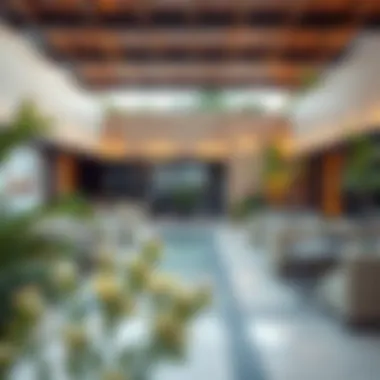
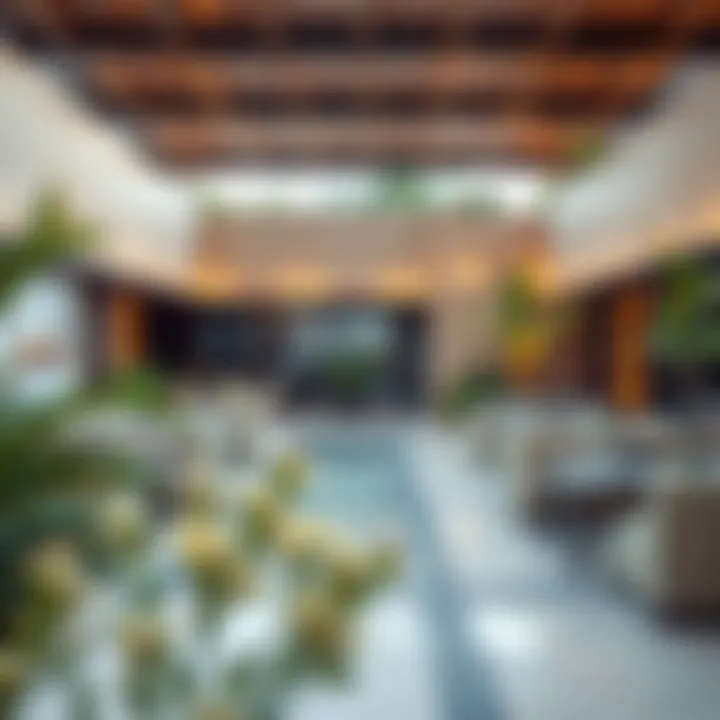
These spaces often host events that celebrate different cultures. Music festivals, art displays, and food fairs can transform a rooftop into an eclectic tapestry of cultural interactions. For example, one can witness a fusion cooking class demonstrating Mediterranean and Asian cuisine right under the sun while lush greenery surrounds you. This blending not only enhances the overall experience but also builds a sense of community and intercultural appreciation.
Additionally, the act of gardening itself can be informed by various cultural practices. A rooftop garden might feature local flora as well as plants from far-off lands, symbolizing the notion that while our backgrounds may differ, our love for nature and beauty can unite us all.
Community Engagement
The social landscape of cities is often marked by isolation. Rooftop gardens like Al Qana challenge that notion through community engagement initiatives. These settings are not just for private leisure but serve as communal grounds where neighbors can work together towards common goals.
Much like tending to a communal garden, residents can participate in workshops on sustainability, landscape maintenance, or simply enjoy social gatherings that reinforce community ties. Regular programs, whether they are yoga sessions or art classes, tend to draw residents out of their shells. People begin to converse, collaborate, and build friendships that might not have occurred in traditional public settings.
Moreover, these spaces can serve as green lungs for urban areas, promoting environmental awareness amongst community members. Residents who contribute to maintaining the rooftop gardens often gain a deeper appreciation for ecology and sustainability, leading to a stronger, more responsible community mindset.
By weaving cultural values into the fabric of everyday life, rooftop gardens can act as a powerful reminder that we are all stewards of our environment, and together we can create something beautiful.
Lifestyle in Al Qana
The rooftop garden lounge at Al Qana isn't just a visual treat but a pivotal part of the lifestyle offered in this unique space. Its design interweaves the charm of nature with urban life, presenting a sanctuary that appeals to both residents and visitors. As people seek environments that meld comfort, relaxation, and socializing, Al Qana's offering becomes a focal point for community interaction, wellness, and leisure activities.
Social Spaces and Interaction
In our fast-paced world, social interaction often takes a back seat. However, Al Qana's rooftop garden lounge serves as a vibrant meeting point where folks can unwind. With its expansive seating areas, shaded nooks for intimate conversations, and open spaces for larger gatherings, it’s designed for leisure.
- Encouragement of Community: The setup promotes community spirit. People come together, facilitating conversations among strangers and making connections that might not happen in more formal settings.
- Events and Activities: Often, Al Qana hosts social events — from yoga sessions to art exhibits. Such activities cultivate a sense of belonging, making everyone feel like they are part of something larger.
- Cultural Exchange: The lounge acts as a canvas for cultural exchange, allowing different cuisines, music, and art forms to intermingle. Visitors can experience a taste of varied cultures while relaxing amidst lush greenery.
This blend of features caters to different social styles and preferences, ensuring that whether you crave a quiet moment with a book or an energetic gathering, there’s a spot for you.
Wellness Benefits
Living in a bustling city like Dubai can sometimes lead to stress and fatigue. The rooftop garden lounge stands against that tide with numerous wellness benefits that enhance the quality of life for its patrons.
- Natural Air Quality Improvement: The greenery of the garden plays a role in purifying the air, making it easier to breathe and promoting overall health. The presence of plants reduces CO2 levels and introduces fresh oxygen, which is vital in an urban setup.
- Mental Health Boost: Studies have shown that exposure to nature dramatically reduces stress and anxiety. Spending time in places like the rooftop lounge can elevate moods and foster relaxation, offering a crucial escape from day-to-day pressures.
- Physical Activity: The space encourages movement, whether it’s a leisurely stroll through the garden or participating in a fitness class. This active lifestyle is not just about physical health but also about fostering social interactions that contribute to mental well-being.
"The presence of green spaces plays a crucial role in enhancing the urban living experience, providing serenity within the chaos of city life."
Economic Implications
The rooftop garden lounge at Al Qana serves not only as a lush green hideaway but also as an influential part of the economic landscape in Dubai. In this section, we will explore the economic ramifications of this innovative space, touching upon its contributions to real estate trends and highlighting investment opportunities that arise from such urban projects.
Real Estate Trends
In today’s fast-paced world, a growing sense of ecology within the realms of urban development is becoming paramount. The rooftop garden lounge exemplifies this trend, reshaping how real estate is perceived and enhancing property values in its vicinity. Here's how:
- Increased Property Values: Spaces like the rooftop garden often lead to an increase in property values in the surrounding areas. Access to nature and relaxation spaces is appealing to homebuyers and renters alike.
- Demand for Green Spaces: As cities expand, the demand for residential areas that integrate green spaces is soaring. Investors and developers are now increasingly seeking to incorporate these elements to boost customer satisfaction and engagement.
- Lifestyle Marketing: Properties that emphasize lifestyle features, including rooftop gardens, are marketed with heavy focus on community and quality of life. This perception attracts diverse demographics, including young professionals and families.
The implications of these trends extend beyond mere property values; they represent a shift in how living spaces are designed and utilized, evolving from everyday dwellings to desirable lifestyle choices.
Investment Opportunities
Delving deeper, the economic landscape surrounding the rooftop garden lounge opens up a wealth of investment opportunities. Here are a few noteworthy avenues:
- Commercial Ventures: Businesses can leverage the lush backdrop of rooftop gardens for cafes or restaurants, enhancing guest experiences. The unique setting can draw consumers looking for fresh dining experiences in a city known for its hustle and bustle.
- Collaborative Spaces: There is potential for partnerships in creating coworking environments that combine recreational facilities with office spaces. This trend aligns with the modern work-life balance mentality, attracting companies and professionals keen on engaging with nature.
- Sustainable Solutions: Investing in environmentally conscious technologies to maintain these gardens can also prove financially favorable. This includes systems for harvesting rainwater or green energy technologies, which can help reduce operating costs long-term, not to mention their contribution to the broader sustainability goals.
"As cities embrace green architecture, the value of properties with rooftop gardens is expected to see a significant rise."
Investment in these types of projects not only helps meet current demands but also sets a benchmark for future developments in urban areas, particularly in Dubai, where a confluence of luxury and nature emerges. As stakeholders begin to realize the economic implications of rooftop gardens, the potential for growth and innovation in this sector of real estate and urban design continues to flourish.
In summary, the economic implications of the rooftop garden lounge at Al Qana extend beyond the immediate aesthetic appeal, cultivating a fertile ground for enhancing property values and exciting investment avenues.
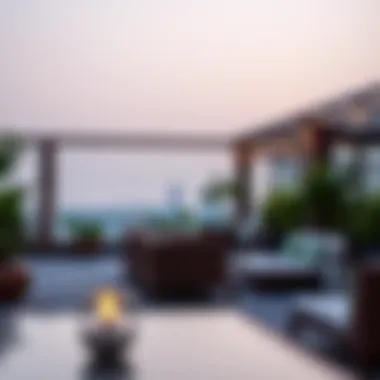
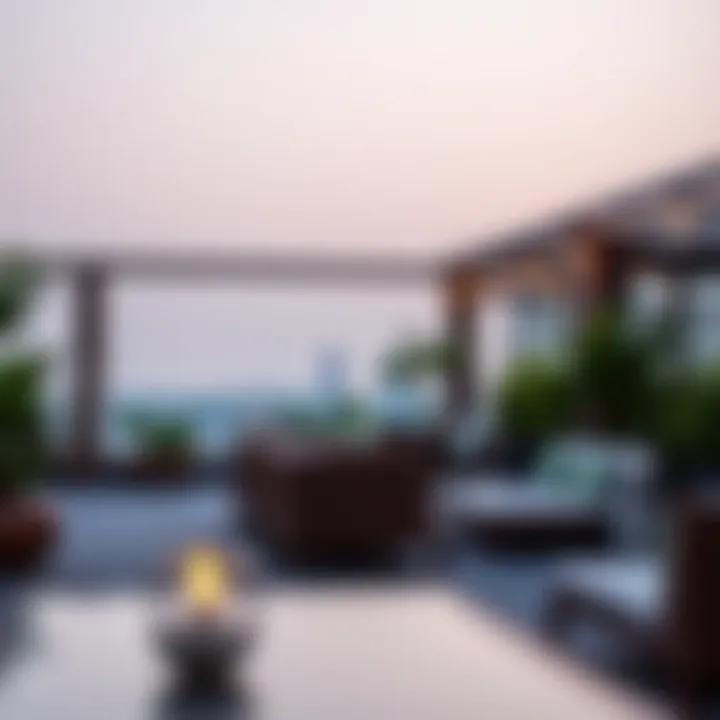
Challenges and Limitations
When delving into the notable features of the rooftop garden lounge at Al Qana, it’s crucial to acknowledge the challenges and limitations that accompany its design and utilization. These aspects not only provide a clearer picture of the rooftop garden's intricacies, but they also highlight the considerations that real estate enthusiasts, investors, and developers must keep in mind when contemplating similar ventures.
Design Constraints
Designing a rooftop garden is no walk in the park. The first thing to keep in mind is structural integrity. The weight of the soil, plants, and additional features like pathways or seating areas can stress the underlying building. There are strict building codes in Dubai that govern how much weight a rooftop can support, meaning that every design must be meticulously calculated. Moreover, aesthetic choices can only go so far when there are practicalities to observe. For instance, while it might be tempting to create a lush tropical garden, local climate conditions — chiefly the high temperatures and aridity — can limit plant selections significantly.
Another important design aspect is accessibility. The design of the lounge must ensure that all users, including those with disabilities, can enjoy the rooftop space. This necessitates integration of ramps and elevators, which can complicate design planning and aesthetics. Not to mention, the layout needs to facilitate movement for groups while providing enough intimate spaces for quiet enjoyment, which presents a unique balancing act.
Maintenance Issues
Maintenance is where the rubber meets the road. Despite the evident benefits of a rooftop garden, sustaining its visual appeal and health requires a fair amount of time and resources. Irrigation systems, for instance, must be efficiently designed to combat the harsh local climate without wasting precious water resources. Regular maintenance becomes an operational task, as different plants have varied watering needs, which can complicate upkeep further.
Furthermore, seasonal changes can wreak havoc on rooftop gardens, even in a place like Dubai. High winds and desert sands can quickly make a pristine space look unkempt, not to mention the potential for pests that can wreak havoc on the delicate ecological balance one aims for.
"A beautifully designed rooftop garden can quickly lose its charm without dedicated and consistent maintenance."
Thus, for investors and developers, considering ongoing operational costs related to maintenance facilities becomes paramount. The initial fascination with the concept can quickly become overshadowed by these realities, putting a damper on the overall investment appeal if not properly managed.
In summary, while the rooftop garden lounge at Al Qana arguably stands as a model of modern urban design, it’s vital to recognize the hurdles involved in bringing such a vision to life. Both design constraints and maintenance issues can serve as double-edged swords in this brave new world of urban greening, making them necessary considerations for all parties involved.
Future Development of Rooftop Gardens
Rooftop gardens have garnered attention not just as aesthetic pleasures but as smart solutions to some pressing urban issues. Their development, especially in places like Al Qana, represents a fusion of architecture and ecology, tailored to meet the needs of modern living. The importance of discussing the future of these spaces is multifaceted. It doesn't only pertain to the enhancement of lifestyle for residents but also touches on environmental sustainability and economic vitality.
The key trends shaping the future of rooftop gardens entail cutting-edge design practices, community engagement, and the utilization of technology to optimize plant growth and maintenance. These aspects all converge to create environments that are not just spaces but sanctuaries. They are becoming essential in urban planning, seen increasingly as a crucial part of city ecosystems aiming to combat urban heat and air pollution.
Innovative Trends in Design
Trends in rooftop garden design are evolving faster than ever, reflecting a myriad of creative approaches and scientific advancements. Here are some notable innovations:
- Vertical Gardens: These gardens utilize vertical space efficiently, allowing for more plants in smaller areas. They combine aesthetics with functionality, providing beautiful greenery while improving insulation.
- Hydroponics and Aquaponics: These soilless gardening techniques promise higher yields with less water, making them ideal for urban settings.
- Smart Irrigation Systems: With technology, watering can be automated based on needs. Sensors gauge moisture in the soil, ensuring plants get just the right amount of water without waste.
- Edible Landscapes: There is a growing trend of incorporating edible plants alongside ornamental ones. This not only beautifies the space but also cultivates a sense of community around shared food sources.
In essence, such innovations make rooftop gardens more adaptable, productive, and engaging. Future designs are likely to balance aesthetics with functionality, reflecting a deeper respect for nature and our environment.
Potential for Expansion
The potential for expansion within rooftop gardens is not limited to the physical space available; it also encapsulates the broader scope of urban involvement and interconnectedness. In cities like Dubai, as urban living continues to rise, the integration of green spaces becomes essential.
- Urban Infill: Unused buildings and neglected rooftops offer untapped opportunities for recreation and food production.
- Community Participation: Community-driven projects can spur a sense of ownership and involvement. Residents can engage in planting, harvesting, and maintaining these spaces, which strengthens community ties.
- Real Estate Appeal: For realtors and developers, incorporating rooftop gardens into properties can enhance value. Homes and commercial spaces that feature green spaces not only draw attention but also command higher prices.
- Health and Wellness Integration: The benefits of greenery for mental and physical health can lead to a growing demand for these spaces. Increased awareness of health and wellness will likely propel more developers to consider rooftop gardens as a standard feature in new projects.
Rooftop gardens are positioned as catalysts for change within urban landscapes. Their expansion embodies a commitment to creating livable environments where nature and urban life coexist harmoniously, promoting not just aesthetic appeal, but vital ecological functions.
Embracing the future of rooftop gardens is about more than just greenery; it's a testament to our dedication to building resilient cities that prioritize both sustainability and community well-being.
By exploring these innovative trends and recognizing the potential for growth, stakeholders, especially investors, realtors, and developers, can align their strategies with the demands of contemporary urban living.
Ending
The rooftop garden lounge at Al Qana stands as a testament to the synergy between urban living and nature, introducing a revolutionary approach to lifestyle spaces in Dubai. This concluding section reflects on the multifaceted importance of the rooftop garden, emphasizing its role not just as a leisure space but as an integral part of the urban ecosystem.
Summary of Insights
Throughout this article, we’ve explored various dimensions of the rooftop garden lounge. The architectural and landscaping elements demonstrate a clever blend of innovation and functionality. The lounge not only elevates the aesthetic appeal of Al Qana but also enhances the well-being of its visitors. By incorporating elements that promote sustainability, it also addresses critical environmental considerations. The garden serves as a new kind of social space, inviting connections among diverse groups, and showcasing the potential for cultural exchange and community engagement. Investors and developers must consider how such spaces can add value to residential and commercial projects. In light of these insights, investing in similar projects could lead to a prosperous future, marking a shift in urban design principles.
Final Thoughts on Al Qana
Al Qana represents a visionary step towards redefining urban experiences. The rooftop garden lounge is more than just an aesthetic addition; it symbolizes a movement towards more sustainable, livable cities. With Dubai being a melting pot of cultures, this garden lounge embodies the essence of community interaction amid serene natural surroundings. By focusing on mental wellness and environmental sustainability, Al Qana is paving the way for future developments in urban architecture within the city and beyond.
Investors and homebuyers should take a moment to consider the projected benefits of such unique spaces. As urban environments become increasingly crowded, the demand for greenery and leisure areas is only likely to grow.
“In the rush to modernize cities, do not forget the importance of nature.”
Embracing such developments can not only enhance property value but also contribute to a healthier lifestyle, creating vibrant communities where people can connect with each other and nature. Al Qana’s rooftop garden lounge is indeed a prime example of how thoughtful integration of nature can rejuvenate urban landscapes.








